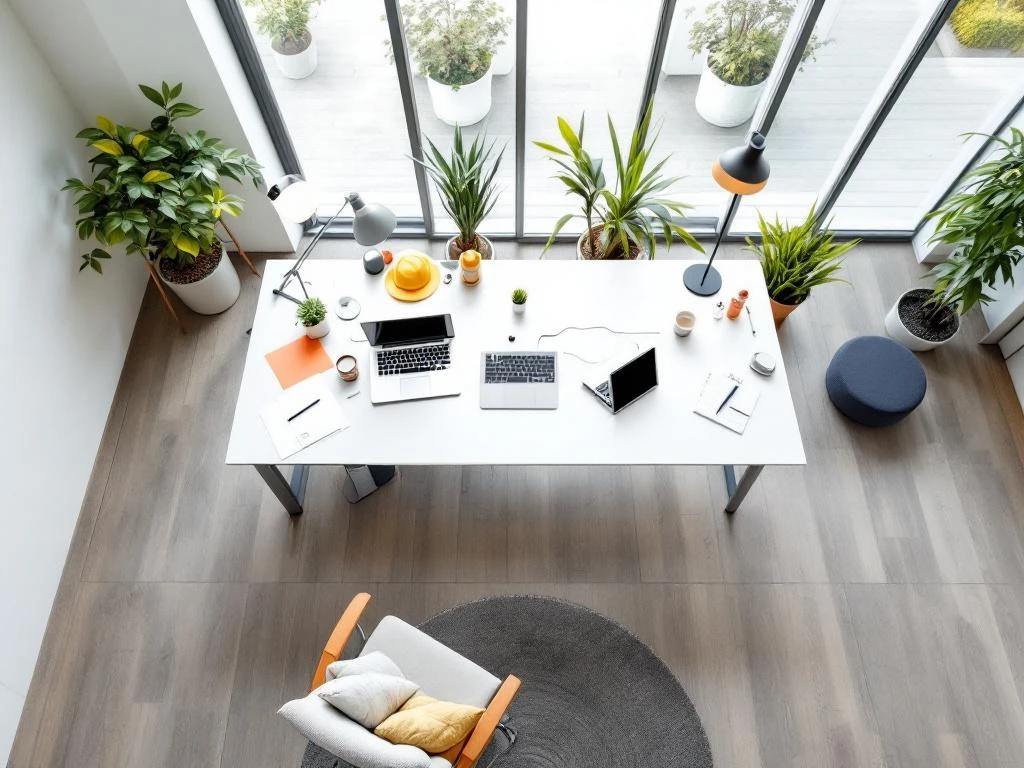Occupational health and safety requirements for office workplaces are legal regulations that protect the health, safety and welfare of employees. These requirements include rules for ergonomic furniture, lighting, climate, noise and workspace. Employers are required to meet these standards, while employees must cooperate to ensure a safe work environment. The main requirements include adjustable desks and chairs, at least 500 lux of lighting, temperature between 20-24°C, no more than 55 dB(A) noise, and at least 7 m² of work space per person.
What are health and safety requirements and why are they important for office workplaces?
The Working Conditions Act (Arbowet) forms the basis for all rules around safe and healthy working in the Netherlands. This law protects you as an employee from health risks and promotes your well-being at work. For office workers, this means that your workplace must meet specific standards that prevent complaints such as back pain, eye strain and stress.
The purpose of Occupational health and safety requirements is twofold: they protect your health and at the same time increase your productivity. A well-equipped workplace not only prevents physical complaints, but also ensures more job satisfaction and better performance. Think of preventing RSI complaints through ergonomic furniture or reducing concentration problems through good acoustics.
Employers have a responsibility to provide a safe and healthy workplace. This means they must provide good workplace equipment, educate about healthy working practices and regularly check that everything still meets the standards. As an employee, you also have obligations: you must use the equipment provided correctly, cooperate with instructions and report unsafe situations.
What are the ergonomic requirements for desks and chairs?
Office furniture is subject to strict NEN standards that ensure a ergonomic work posture. A desk should be height adjustable between 62 and 82 centimeters, allowing you to work both sitting and standing. The work surface should be at least 120 by 80 centimeters and provide adequate legroom of at least 60 centimeters deep and 70 centimeters wide.
Office chairs must meet even more requirements. The seat height should be adjustable between 42 and 55 centimeters, with a seat depth of 38 to 47 centimeters. The backrest must support your lower back and be adjustable in height and angle. Armrests are mandatory and must be adjustable in height, width and depth. The chair must be stable with five wheels and turn smoothly.
Setting your workplace furniture correctly is as important as its quality. Adjust your chair so that your feet are flat on the floor and your knees are at a 90-degree angle. Your elbows should rest relaxed on the armrests as you type. The desk should be at elbow height when you sit up straight. Alternate frequently between sitting and standing to keep your body moving.
What are the lighting requirements for an office workplace?
An office workstation should have a minimum of 500 lux of lighting for general office work. For precision work such as technical drawing, this can go up to 750 lux. This illuminance should be measured at desk level and evenly distributed over the work surface without annoying shadows.
Preventing glare and reflections on monitors is important for your eye comfort. Place your monitor at right angles to the window to avoid direct light. Use blinds or curtains to temper bright sunlight. Choose fixtures with good shielding that diffuse light without direct light beams in your field of vision.
The ideal lighting combines daylight with artificial light. Daylight has a positive effect on your biological clock and mood, but it is not always sufficient or constant. Supplement this with adjustable desk lamps and ceiling lights. Make sure your workspace is no more than 3 meters from a window for optimal daylighting. LED lighting with a color temperature between 3000K and 4000K provides the most natural light.
What should the indoor climate in an office be like according to the Occupational Safety and Health Administration?
The temperature in an office should be between 20 and 24 degrees Celsius for light sedentary work. In summer, this may rise to a maximum of 26 degrees. This temperature should be constant without large fluctuations throughout the day. At temperatures outside this range, your concentration decreases and health problems may arise.
Humidity should be between 30 and 70 percent, with an ideal rate around 40 to 60 percent. Too dry air causes eye and respiratory irritation, while too humid air can promote mold. Modern air conditioning systems control this automatically, but if you have problems, you can use humidifiers or dehumidifiers.
Ventilation is necessary for sufficient oxygen and removal of CO2. The standard prescribes a minimum of 30 cubic meters of fresh air per person per hour. This prevents headaches, fatigue and difficulty concentrating. Note that ventilation should not cause a draft; air velocity should be no more than 0.15 meters per second. Temperature differences between head and foot level should not exceed 3 degrees.
What are the requirements for screen work?
Your monitor should be in the correct position: the top at eye level when you are sitting upright, 50-70 centimeters away from your eyes. The screen should tilt back slightly (10-20 degrees) to minimize reflections. When using multiple screens, place the main screen directly in front of you and secondary screens at an angle of up to 35 degrees.
Screen quality must meet strict requirements. The screen must completely flicker-free be with a refresh rate of at least 75 Hz. Contrast and brightness should be adjustable to adapt to ambient lighting. Resolution should be sufficient to display text sharply without having to zoom in. Modern screens with blue light filters help reduce eye strain.
To prevent RSI complaints and eye strain, there is a mandatory break rule: after every 2 hours of screen work, you are entitled to a 10-minute break. Use this time to relax your eyes by looking into the distance and moving your body. Blinking your eyes regularly prevents dry eyes. Alternate screen work with other tasks such as phone calls, consultations or administration without a screen.
What are the noise and acoustic standards for offices?
For concentration work, the noise level should not exceed 45 to 55 dB(A). This corresponds to the sound of a quiet conversation. In open office spaces, this is often a challenge due to phone noise, conversations and equipment. At higher noise levels, your concentration decreases and stress occurs.
Noise control measures are often necessary in modern offices. Acoustic ceiling panels absorb sound and reduce reverberation. Floor coverings or carpet tiles dampen walking noise. Partitions between workstations, preferably with sound-absorbing material, create quieter work zones. Plants can also help absorb sound while creating a pleasant atmosphere.
Additional guidelines apply to open office spaces. Create different zones for different activities: quiet zones for concentrated work, consultation areas for conversations and call booths for phone calls. The distance between workstations should be at least 1.5 meters to reduce noise pollution. In quiet areas, the noise level should be no more than 35 dB(A), similar to a library.
What are the space requirements for each workstation?
Each employee is entitled to a minimum of 7 square meters of floor space in an office space. This does not include common areas such as hallways and meeting rooms. For a optimal office layout when renting office space 10 to 12 square feet per person is often maintained for greater comfort and flexibility.
There should be at least 1 meter of free space around your workstation. This means that you can slide your chair completely backwards without running into obstacles. Walkways should be at least 90 centimeters wide, main routes even 120 centimeters. This space is needed for safe evacuation and comfortable movement through the office.
The ceiling height should be at least 2.60 meters for a healthy indoor environment and sufficient air volume. At lower ceilings, people can feel stuffy and additional ventilation is needed. Escape routes should always remain clear according to fire safety requirements: at least two exits per floor, emergency lighting and clear signage. Workstations should never block escape routes.
What about health and safety requirements for home workplaces?
Employers remain responsible for their employees' working conditions, even when working from home. They must provide ergonomic furniture and equipment or offer reimbursement for purchase. This includes, at a minimum, an adjustable office chair, a desk or standing workstation, and an external monitor with keyboard and mouse for laptop users.
The same ergonomic guidelines apply to setting up your home office as in the office. Choose a quiet space with adequate natural light and ventilation. Provide a separate workspace, not the kitchen table or couch. The workspace should be free of distractions and provide sufficient privacy for confidential conversations. Good Internet connection and adequate lighting are necessary.
Reimbursement arrangements vary by employer but should be reasonable. Consider allowances for internet, energy, desk furniture and office supplies. Employers may monitor the home office for compliance with health and safety requirements, but only with your permission. Many companies offer a home office budget or provide materials on loan. Discuss clear agreements on allowances and responsibilities with your employer.
What should a risk inventory for office work include?
A Risk Inventory and Evaluation (RI&E) for office environments must identify all possible health risks. Mandatory components are: workplace design, monitor work, indoor climate, lighting, noise, psychosocial workload and safety. The severity and likelihood must be assessed for each risk.
Physical risks include RSI due to incorrect work posture, eye problems due to poor lighting, back problems due to incorrect furniture and headaches due to poor indoor climate. Psychosocial risks include work pressure, undesirable behavior, unclear division of labor and lack of autonomy. These factors can lead to stress, burnout or absenteeism.
The action plan describes concrete measures to reduce risks, with priorities, responsibilities and deadlines. The RI&E must be updated at least every 4 years, or earlier in the event of major changes such as a move or reorganization. Employees must be involved in the inventory and the prevention officer coordinates the implementation. A certified occupational health and safety service tests whether the RI&E is complete.
Key health and safety requirements for a healthy office workplace: what to remember?
The most important Occupational health and safety standards for offices in a row: adjustable furniture (desk 62-82 cm, ergonomic chair), minimum 500 lux lighting, temperature 20-24°C, maximum 55 dB(A) noise, minimum 7 m² of work space and 10 minutes break every 2 hours of screen work. These basic standards are the foundation for a healthy workplace.
A practical checklist for employers: conduct an RI&E, provide ergonomic furniture, ensure good lighting and climate control, limit noise pollution, provide sufficient working space and instruct employees on healthy working. For employees: set up your workplace correctly, take regular breaks, alternate postures, report complaints immediately and cooperate on improvements.
For more information on occupational health and safety requirements, contact the Labor Inspectorate, industry associations or certified occupational health and safety services. Online tools help you check your workplace. Investing in good working conditions pays off: it increases productivity, reduces absenteeism and improves job satisfaction. When looking for office space to rent in Amsterdam or elsewhere, pay close attention to whether the space meets all health and safety requirements. At Co-Office, we understand the importance of a healthy work environment. Our flexible workspaces meet all health and safety standards and provide the ideal environment for productive and healthy work. Want to learn more about how we can create your ideal workspace? Then please contact with us.

